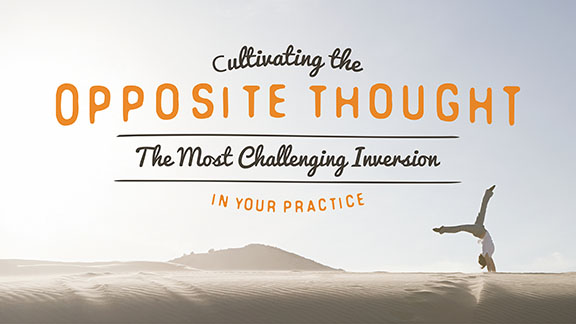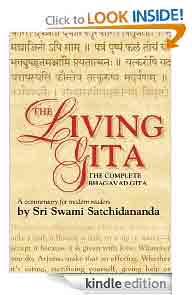 One of Patanjali’s sutras buried in the Second Pada is: “Pain that has not yet come is avoidable” (2.16). This is very similar to, I would even say, exactly, what the Buddha taught: that suffering can end—as stated in the Third Noble Truth—though we hardly seem to get there because the first two Truths (there is suffering and suffering stems from desire) are so compelling that we stay focused on those. And yet, Buddha said there is an end to suffering, a choice that can be made. The opposite of suffering is what Patanjali offers in the second sutra: union with Divine Consciousness, the experience of Yoga, the restraint of the modifications of the mind-stuff.
One of Patanjali’s sutras buried in the Second Pada is: “Pain that has not yet come is avoidable” (2.16). This is very similar to, I would even say, exactly, what the Buddha taught: that suffering can end—as stated in the Third Noble Truth—though we hardly seem to get there because the first two Truths (there is suffering and suffering stems from desire) are so compelling that we stay focused on those. And yet, Buddha said there is an end to suffering, a choice that can be made. The opposite of suffering is what Patanjali offers in the second sutra: union with Divine Consciousness, the experience of Yoga, the restraint of the modifications of the mind-stuff.
And just how do we equate pain and suffering? Patanjali gives us a definition of painful vs. painless vritti, the latter based on direct experience, clear inference or authoritative testimony, what I termed: Knowledge. Painful vritti, misperception (he said hi to me, we’re getting married tomorrow!), conceptualization (I bet aliens will be arriving any day!) and memories (oh to be young and energetic!) sound a lot like suffering caused by desire—the act of wanting something other than what is. And so in this article, I propose that the pain Patanjali refers to is the suffering of Buddha’s teachings.
With that, we still have the thorny issue of actual pain, that moment of experiencing a knife cutting into a finger, a bone being broken. Or emotional/mental pain, a stabbing feeling that comes with an experience, arguing with a spouse, losing a job, a loved one dying. Physical pain lasts as long as the painful event itself, however long it takes to have the injury addressed, and the body given time to heal. This leaves us with emotional/mental pain, the type that is most susceptible to turning into pain that can be avoided, and the suffering that Buddha offered can end. In a simpler way of suggestion, any pain can turn into pain/suffering when it lasts longer than the event that created the pain. Radical? Perhaps.
Before we go there, how about we just avoid painful events altogether? Sounds pretty simple. Until we begin to eliminate what could cause us pain and we realize that we no longer can use a knife, so cooking and eating are out. So is any kind of exercise that can result in a broken bone. And well, relationships can be painful, so never doing that again. Nix the family, friends, future mates. Ah yes, becoming a hermit in a cave might be just the ticket. Except, well, hunger, cold, and loneliness can be painful. This avoidance is termed aversion by Patanjali in sutra 2.8: “Aversion is that which follows identification with painful experiences.”
A student could argue that aversion naturally follows those painful experiences. Except a more advanced student would point to the word, “identification” in the definition. It is when we identify with the painful experience, when we believe it is what we are, that aversion becomes a follow-on action. Now we are back to the third and fourth sutras. When the vritti are restrained, we experience Divine Consciousness, Yoga. Otherwise, we identify with the vritti and believe that is what we are. The painful experience is us. It becomes a loop that is hard to get out of. When we avert or avoid, we are identified with memories of painful experiences and, no longer being present, we cannot experience Yoga (nor the chance to see that maybe this current event repeat is not painful). So aversion actually keeps us stuck in pain.
Indeed, Patanjali highlights this very issue with sutra 2.17: “The cause of that avoidable pain is the union of the Seer and Seen.” What Patanjali states from the beginning is that we are the Seer, Divine Consciousness. Yet, somehow, instead of staying in the role of Seer, or even more active, keep seeing, we instead slip into the role of believing we are what is seen—a static, inanimate object or event that is “dead” since it is no longer happening because the moment it happened in is gone. We identify with a painful event and continue to “feel” the pain long after the event has ended.
An example of this is an employee being called into the boss’ office, sitting down and hearing that the job she has been doing is being eliminated and so her employ is being terminated. In the moment of hearing that information, several things can happen. One, she can hear it and feel immediate sensations in the body, a clenching of the stomach, a stabbing in the heart, a pounding in the head, common sensations associated with emotional/mental pain. Two, she could go into shock, a sense of ears plugging up, heart stopping, numbness and basically delaying any reaction to the information. Or three, she could react with aversion, a disbelief, a pushing away of the words being delivered in the moment. This last could be accompanied by any set of sensations from scenario one or two. And here is where the initial shock or pain of finding out that information can turn into pain or suffering. The employee walks out of the office and the vritti begin, “What?! I gave my life to this company and this is how I’m repaid?” or “My boss has always hated me, always! I never stood a chance!” or “What am I going to tell my family? This is embarrassing, shameful, horrible!”
These vritti are painful. Most likely, none of them are based in knowledge, and even if there is some fact to the amount of time dedicated to working, the boss-employee relationship, the reaction of family, not one of the above thought whirlwinds is helpful to the person who just got laid off! In the moment of termination, the employee feels what she feels—pain, anguish, rejection, hurt—and what happens next is a bunch of thought whirlwinds that keep that pain going in the next several moments (hours, days, months) after the employee walks out of the office. The event, the termination, is over. It happened once. And the painful vritti that come up keep the event happening again, and again, and again, and again. Now pain turns into major pain or suffering. Not to mention what happens when the employee goes back and tells her co-workers what happened, reliving the entire event over again, perhaps with characterizations of the key players, perhaps an additional flourish of detail that didn’t happen but made management look bad and the employee look good (now we can begin to see how memories are not a basis of knowledge), and then the employee goes home and does it all over, again.
How do we not get drawn into vritti that keep the painful event playing in our heads? Patanjali offers a simple way to immediately shift our perspective, sutra 2.33: “When disturbed by negative thoughts, opposite (positive) ones should be thought of. This is Pratipaksha Bhavana.” And as simple as this is, it can be deceptive. The opposite, or positive thoughts, are only effective when they are based in knowledge. Hence, having just been fired, to have someone tell me the opposite—that I haven’t been fired—is not factual. Nor is, “the company made a big mistake.” Well, not according to the company. And a classic response, “You’ll find another job in no time.” Who knows when anyone will find another job? These vritti are as unhelpful as the ones that were berating.
So which vritti would be positive and based in knowledge? These will vary widely between individuals and will depend on what resonates with a person’s heart. A few that come to mind are, “Ouch! Didn’t see that coming, even though I know I did the best I could,” or “It hurts to lose this job; however, I still enjoy this field of work and will see what else is available,” or “This is not fun, and yet, I’ve been wanting a change of scenery, and now I can act on that.” Perhaps it is, “Gosh, I’ve never enjoyed working with my boss. Here’s a chance to find a work relationship that supports me.” Or, “I’m terrified to tell my family. I wonder who I can ask to help me find a way to talk to them about this.” These vritti all have in common 1) acknowledgement of the event; 2) acknowledgment of the pain; and 3) no repeating the painful event.
Of course, in the aftermath of such an event, pain will most likely be felt again. In the example above, say the employee, a Yoga student by the way, is driving home. She is focusing on her breath, on driving and even so, intermittent flashes of being fired pop up in her mind (memory) and that initial stabbing pain of the event returns. She allows herself to cry, curse, feel heartbroken, and then she returns to her breath and driving the car. She sees her mind vacillating between the event (now in the past) and what is happening in this moment, driving the car, taking a breath. She realizes that when she focuses on driving or breathing (an action that conveniently is always happening in the now), she is calmer. Which leads her to create a mantra, “I am breathing, I am driving, I am breathing, I am driving.” She sees how the pain passes (most scientific research supports that feelings/emotions last anywhere from 30–90 seconds) and with the mantra, is practicing Pratipaksha Bhavana. The “positive” thoughts are simply what is true in the moment, that she is breathing and that she is driving. Coincidentally, this is her direct experience in the moment, what is actually occurring; it is knowledge.
Another way to work with pain is to consider it a wake up call. In sutra 2.1, Patanjali offers “Accepting pain as help for purification, study, and surrender to the Supreme Being constitute Yoga in practice.” Tapas is the Sanskrit word for “accepting pain” and has the additional definition of being “a purifying flame.” Just like the body produces a fever to kill germs, painful events give us the opportunity to “burn away” the painful vritti by not believing them.
Returning to our intrepid yogini who just got fired, while driving home she started to see how a constant recalling of the original event led to pain or suffering. At first, she attended to her breath, or to driving, a one-pointed focus associated with devotion. Then she started using a mantra, doing Japa Yoga, repeating what is true in the moment. Not only did pain itself became a trigger to choose practicing Patanjali’s teachings, in doing so the yogini builds a foundation of peace and calm as a direct experience—while simultaneously lessening the pull of, or purifying, the painful vritti clamoring for attention. Her spiritual health increases and in the future, she becomes more immune to the painful vritti. The added bonus is that, in a state of Yoga, she can now be open to Divine Consciousness which could offer any number of helpful insights, such as how she might like to approach a relationship with a new boss, or starting a new career that she has always wanted to pursue, or simply how to tell her family the news in a direct and compassionate way.
Ah, but Patanjali says we can avoid future pain all together, not just get out of the cycle of it. And this brings us to sutra 2.26, “Uninterrupted discriminative discernment is the method for its removal.” The “it” is ignorance, the reason why the Seer identifies with the Seen (sutra 2.24). We don’t know, we haven’t had enough experience to recognize when we are identified with Divine Consciousness and when we are identified with painful vritti (and I would wager, it’s because we are identified with the painful vritti 99.9 percent of the time, we come to feel like it’s what is “real”). And, since this mis-identification is the cause of avoidable pain, when we remove it, we avoid the pain completely. It is no mistake that Patanjali uses “discriminative discernment,” two words that have almost identical meanings, in this sutra, highlighting that we really need to get it, to double down on recognizing what is the Seer and what is Seen, to know when we are identified with the Seer (experiencing Yoga, calm, peace, joy, unconditional love) and when we are identified with the Seen (experiencing pain or suffering). And he encourages us to do it in every moment, uninterrupted.
Once again, we return to the example. Imagine the yogini has been practicing discriminative discernment all day as she is called into her boss’ office. She sits down, and the boss gives her the news. She feels a sharp inhale of breath, a moment of holding it, and in releasing the breath recognizes that she is still alive. All that has happened is her job has ended. She is still goodness, love, compassion, vibrancy, yes, Divine Consciousness, that she has always been. It is the job that has ended, not her being. Divine Consciousness has been through this kind of event countless times, and Divine Consciousness has continued past such an event, into a new job, a new career, a smaller apartment, unemployment, selling possessions to make ends meet, another new job, into a divorce, into a new relationship, out of that relationship, back to school, on to retirement, welcoming babies that will go through similar, if not the exact same, events as the yogini has.
In the end, we cannot avoid losing jobs, losing loved ones, getting sick, and having bouts of memory that bring up such events again and again. What we can do is avoid future pain when, and after, we go through such events by choosing Yoga. We do this by turning away from the painful vritti and focusing on what is true now, in this moment, even if it is simply the breath moving in and out. In this way, we become grounded in the knowledge that we are Divine Consciousness, and we experience peace, joy, and unconditional love no matter what is happening.
 Beth Hinnen began her Yoga teaching path with the Integral Yoga Teacher Training Program in 2001. Afterward, she took the Intermediate, Advanced, Raja, and Prenatal trainings. With over 1,000 hours in Yoga certifications (including Structural Yoga Therapy), Beth taught in the New York City area for over 10 years, both privately and in classes. In 2013 she moved back to her native state, Colorado, to open a common-denominational spiritual center named Samaya (“right timing” in Sanskrit) following Sri Swami Satchidananda’s teaching, “Truth is one, paths are many.” She currently also studies Buddhism.
Beth Hinnen began her Yoga teaching path with the Integral Yoga Teacher Training Program in 2001. Afterward, she took the Intermediate, Advanced, Raja, and Prenatal trainings. With over 1,000 hours in Yoga certifications (including Structural Yoga Therapy), Beth taught in the New York City area for over 10 years, both privately and in classes. In 2013 she moved back to her native state, Colorado, to open a common-denominational spiritual center named Samaya (“right timing” in Sanskrit) following Sri Swami Satchidananda’s teaching, “Truth is one, paths are many.” She currently also studies Buddhism.


